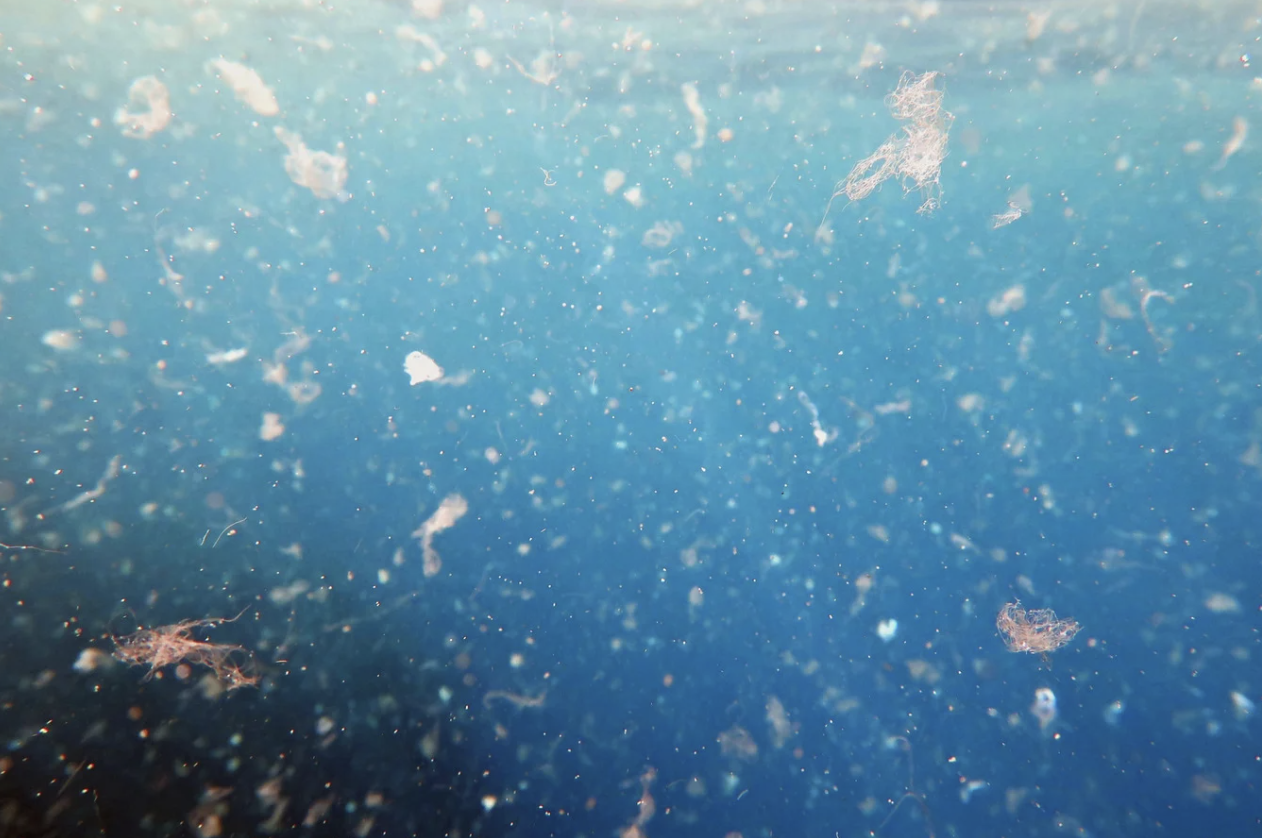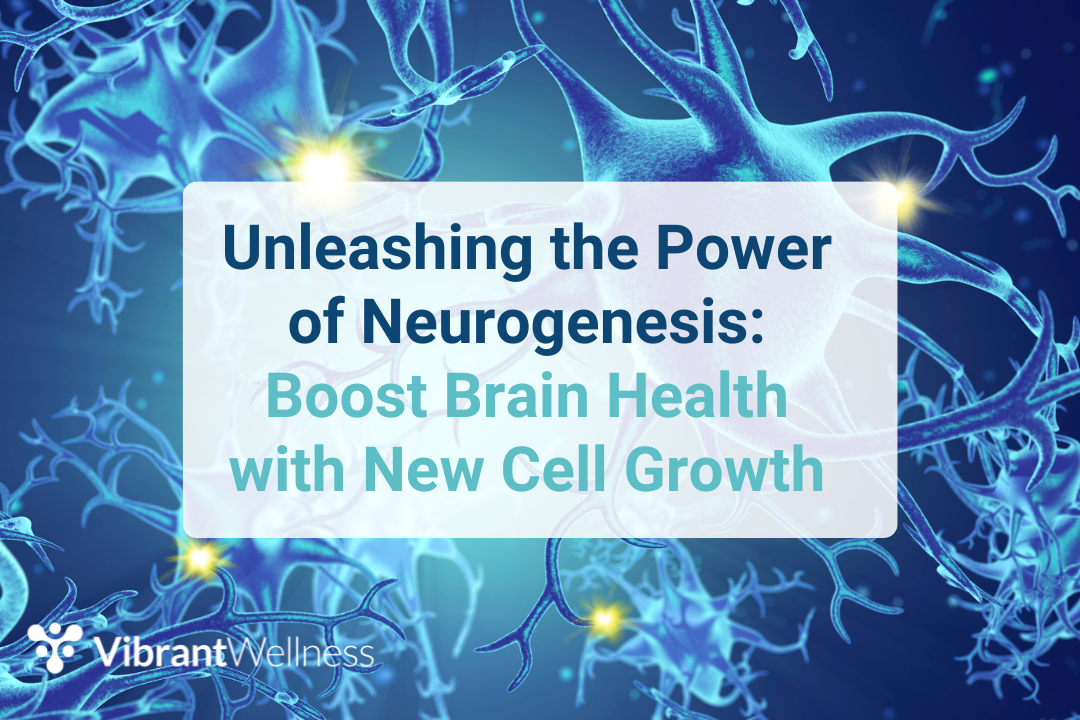How PFAS and Microplastics Impact Brain Health and Mental Function
Every day, we are exposed to thousands of synthetic chemicals—many of which remain in our bodies for years, disrupting critical biological functions. Among the most concerning are per- and polyfluoroalkyl substances (PFAS) and microplastics, two pervasive environmental toxins that have infiltrated our air, water, food, and even the human brain.
Once inside the body, these persistent pollutants cross the blood-brain barrier (BBB), disrupt neurotransmission, trigger neuroinflammation, and may contribute to cognitive decline, mood disorders, and neurodevelopmental conditions¹⁻³.
Recent studies have detected PFAS accumulation in brain tissue, raising concerns about its potential role in neurotoxicity, neurodegenerative diseases, and psychiatric disorders⁴⁻⁶. Microplastics, often laden with endocrine-disrupting chemicals like bisphenols, phthalates, and heavy metals, introduce additional neurotoxic burdens by interfering with dopamine, serotonin, and glutamate signaling⁷⁻⁹. These disruptions may not only accelerate brain aging but also increase the risk of conditions like ADHD, depression, and anxiety¹⁰⁻¹².
Despite growing awareness, PFAS and microplastics remain largely unregulated, making it nearly impossible to avoid exposure completely. This article explores how these toxins affect brain health, the mechanisms behind their neurotoxic effects, and evidence-based strategies to mitigate their impact. Understanding these hidden threats is the first step in taking control of our neurological well-being.
Table of Contents
What Are PFAS and Microplastics?
PFAS: The “Forever Chemicals” Lurking in Everyday Life

Per- and polyfluoroalkyl substances (PFAS) are a class of synthetic chemicals widely used for their water, grease, and stain-resistant properties. These compounds are found in non-stick cookware, food packaging, textiles, personal care products, and industrial applications¹³. PFAS are often referred to as “forever chemicals” due to their extreme persistence in the environment and human body¹⁴.
Once absorbed, PFAS accumulate in the bloodstream, organs, and even the brain, where they have been detected in cerebrospinal fluid and brain tissue¹⁵⁻¹⁷. These chemicals bind to proteins, interfere with endocrine and immune signaling, and have been linked to neurological disorders, metabolic dysfunction, and carcinogenesis¹⁸⁻²⁰.
Among the most well-studied PFAS compounds are perfluorooctanoic acid (PFOA) and perfluorooctane sulfonic acid (PFOS), both of which have been associated with neurodevelopmental and neurodegenerative diseases²¹.
Although the use of long-chain PFAS like PFOA and PFOS has declined due to regulatory efforts, they have been replaced by short-chain PFAS alternatives, which may be just as harmful but less studied²². Given their widespread environmental contamination, nearly all humans have detectable levels of PFAS in their blood, with exposure occurring primarily through contaminated food, water, and household products²³.
Microplastics: A Hidden Neurological Threat

Microplastics (MPs) are plastic particles smaller than 5 mm, while nanoplastics (NPs) measure less than 1 µm²⁴. These particles originate from degraded plastic waste, synthetic textiles, food packaging, and even personal care products²⁵. Due to their microscopic size, MPs and NPs are now ubiquitous in air, water, soil, and the food chain, meaning they are ingested, inhaled, and absorbed into human tissues daily²⁶.
Recent research has confirmed that microplastics can cross the blood-brain barrier (BBB), accumulating in neuronal tissues and cerebrospinal fluid²⁷⁻²⁹. Once in the brain, they induce oxidative stress, neuroinflammation, mitochondrial dysfunction, and disrupt neurotransmitter balance³⁰⁻³².
Many MPs/NPs also carry harmful additives such as phthalates, bisphenols, and heavy metals, which can exacerbate neurotoxicity by interfering with dopamine, serotonin, and acetylcholine signaling³³.
Exposure to microplastics has been linked to cognitive decline, behavioral alterations, and neurodevelopmental defects in both animal models and emerging human studies³⁴⁻³⁶. Given their pervasive nature and lack of biodegradability, MPs and NPs represent a growing environmental and neurological health concern.
How PFAS and Microplastics Enter the Brain
Breaking Through the Blood-Brain Barrier (BBB)

The blood-brain barrier (BBB) is a highly selective membrane that protects the brain from toxins, pathogens, and harmful substances. However, research has shown that both PFAS and microplastics can penetrate this protective shield, accumulating in neuronal tissues, cerebrospinal fluid, and brain regions critical for cognition and behavior³⁷⁻³⁹.
PFAS are highly lipophilic and bind to albumin and other plasma proteins, which facilitates their transport across the BBB⁴⁰. Some PFAS compounds, such as PFOA and PFOS, have been found in the brainstem, hippocampus, and hypothalamus, where they may disrupt neurotransmission and neuroimmune signaling⁴¹. Additionally, PFAS exposure has been shown to alter tight junction integrity, increasing BBB permeability and allowing more toxins to reach the brain⁴².
Microplastics and nanoplastics (NPs) can enter the brain through two primary routes:
- Direct translocation across the BBB: Studies indicate that smaller MPs/NPs (~0.2 µm) are more readily absorbed and transported across endothelial cells via endocytosis and transcytosis⁴³.
- The olfactory nerve pathway: Inhaled MPs/NPs can bypass the BBB entirely by traveling through the olfactory bulb and trigeminal nerves, directly infiltrating brain tissue⁴⁴.
Neurotoxic Consequences of PFAS and Microplastic Accumulation

Once inside the brain, PFAS and microplastics disrupt normal neurological function through multiple pathways:
- Neuroinflammation: Both toxins activate microglia and astrocytes, leading to the release of pro-inflammatory cytokines (TNF-α, IL-6, IL-1β), oxidative stress, and neuronal damage⁴⁵.
- Neurotransmitter Disruption: PFAS interfere with dopamine, serotonin, glutamate, and GABA signaling, potentially contributing to mood disorders, cognitive decline, and neurodevelopmental conditions⁴⁶. Microplastics carry endocrine-disrupting chemicals that may also alter acetylcholine and neurotrophic factor levels, affecting memory, learning, and synaptic plasticity⁴⁷.
- Mitochondrial Dysfunction & Apoptosis: Exposure to PFAS and MPs leads to mitochondrial damage, impaired ATP production, and increased neuronal apoptosis, further accelerating neurodegeneration and cognitive decline⁴⁸.
The cumulative impact of chronic exposure to these neurotoxic pollutants raises serious concerns about long-term brain health, particularly in vulnerable populations such as children, pregnant women, and individuals with preexisting neurological conditions⁴⁹.
Neurological and Mental Health Impacts
Cognitive Impairment & Neurodegeneration
Chronic exposure to PFAS and microplastics has been linked to cognitive decline, neuroinflammation, and structural brain changes associated with neurodegenerative diseases⁵⁰⁻⁵². Studies have detected PFAS accumulation in the hippocampus, a brain region essential for memory formation and learning, suggesting a role in Alzheimer’s disease (AD) and other dementias⁵³. Microplastics, particularly nanoplastics, have also been shown to trigger tau hyperphosphorylation and β-amyloid accumulation, two hallmarks of AD⁵⁴.
Additionally, dopaminergic neurotoxicity caused by PFAS exposure may contribute to Parkinson’s disease (PD) by reducing dopamine levels, impairing motor function, and increasing oxidative stress⁵⁵. Microplastics, especially those containing toxic additives like bisphenols and phthalates, have been linked to mitochondrial dysfunction and neuronal apoptosis, further accelerating neurodegeneration⁵⁶.
Mental Health Disorders: Anxiety, Depression, and ADHD

There is increasing evidence that PFAS and microplastics interfere with neurotransmitter systems, particularly serotonin, dopamine, and glutamate, which play essential roles in mood regulation and cognitive function⁵⁷. Animal studies have demonstrated that PFAS exposure can induce anxiety-like behavior and depressive symptoms by altering serotonin receptor activity and increasing neuroinflammatory cytokines⁵⁸.
In children, prenatal and early-life exposure to PFAS has been correlated with an increased risk of ADHD, with studies showing altered dopamine signaling, executive dysfunction, and attentional deficits⁵⁹. Similarly, microplastic exposure has been linked to behavioral and cognitive disturbances, including hyperactivity, memory deficits, and impulsivity⁶⁰.
Developmental and Behavioral Risks
Children and developing fetuses are especially vulnerable to PFAS- and microplastic-induced neurotoxicity. Prenatal exposure to PFAS has been associated with reduced IQ, impaired language development, and an increased risk of neurodevelopmental disorders⁶¹. Animal studies suggest that microplastics disrupt neural stem cell differentiation, leading to altered synaptic development and long-term behavioral abnormalities⁶².
The combined impact of neuroinflammation, mitochondrial dysfunction, and endocrine disruption suggests that these environmental toxins may contribute to the rising prevalence of neurodevelopmental and psychiatric disorders worldwide⁶³.
Clinical Considerations & Testing
The Role of Advanced Testing in Identifying PFAS & Microplastic Toxicity
Given the growing body of evidence linking PFAS and microplastics to neurotoxicity, cognitive decline, and neuroinflammation, advanced functional testing is critical for assessing exposure and guiding personalized interventions. Vibrant Wellness offers cutting-edge panels that provide objective, data-driven insights into the neurological and toxic burden associated with these environmental pollutants.
Vibrant’s PFAS Panel: Measuring the “Forever Chemicals” in the Body
The Vibrant PFAS Panel is a highly sensitive test designed to detect a wide range of per- and polyfluoroalkyl substances in the bloodstream. Given that PFAS accumulate in the brain, cerebrospinal fluid, and key organs, this panel provides a critical tool for:
substances in the bloodstream. Given that PFAS accumulate in the brain, cerebrospinal fluid, and key organs, this panel provides a critical tool for:
- Assessing total PFAS body burden and identifying specific PFAS compounds that may contribute to neurotoxicity.
- Tracking exposure sources from contaminated water, food, or occupational settings.
- Correlating PFAS levels with neurological symptoms, cognitive dysfunction, and immune dysregulation.
With PFAS exposure being nearly universal, this panel allows clinicians to determine whether an individual’s toxic load may be contributing to brain fog, mood disorders, or neurodegenerative processes.
Neural Zoomer Plus: Evaluating PFAS & Microplastic-Induced Neurological Damage
The Neural Zoomer Plus is an advanced neurological health panel that provides comprehensive insights into brain inflammation, autoimmunity, and blood-brain barrier integrity. Since PFAS and microplastics have been linked to neuroinflammation, BBB disruption, and neurotransmitter imbalances, this test is invaluable for identifying early neurotoxic effects.
brain inflammation, autoimmunity, and blood-brain barrier integrity. Since PFAS and microplastics have been linked to neuroinflammation, BBB disruption, and neurotransmitter imbalances, this test is invaluable for identifying early neurotoxic effects.
Key markers include:
- Blood-brain barrier permeability markers (Occludin, Zonulin, S100B) – to assess whether PFAS exposure has compromised the brain’s protective barrier.
- Neuroinflammation markers (GFAP, IBA1, MBP, TDP-43) – to detect microglial activation and neurodegenerative processes triggered by PFAS and microplastic accumulation.
- Neurotransmitter-associated antibodies – to assess whether PFAS exposure has disrupted dopamine, serotonin, or glutamate signaling, leading to symptoms such as anxiety, depression, ADHD, or cognitive dysfunction.
Since PFAS and microplastics have been shown to trigger neuroinflammatory cascades, mitochondrial dysfunction, and oxidative stress, the Neural Zoomer Plus helps connect environmental exposures to neurological symptoms.
Total Tox Panel: Assessing Combined Environmental Toxicity
PFAS and microplastics rarely act alone—they coexist with heavy metals, pesticides, mycotoxins, and other environmental pollutants, creating synergistic neurotoxic effects. The Vibrant Total Tox Panel offers a comprehensive evaluation of three major categories of environmental toxins:
environmental pollutants, creating synergistic neurotoxic effects. The Vibrant Total Tox Panel offers a comprehensive evaluation of three major categories of environmental toxins:
- Heavy Metals, such as mercury, lead, and cadmium, exacerbate PFAS-induced neurotoxicity and cognitive impairment.
- Environmental Toxins, including plastic-derived phthalates, bisphenols, and VOCs, amplify the neuroendocrine-disrupting effects of microplastics.
- Mycotoxins, which are mold-derived toxins that have been shown to worsen blood-brain barrier permeability and immune dysregulation when combined with PFAS exposure.
By identifying co-exposures and total toxic load, the Total Tox Panel enables clinicians to develop targeted detoxification strategies to reduce neuroinflammation, mitochondrial stress, and neurochemical imbalances caused by environmental pollutants.
Who Should Be Tested?
Testing for PFAS, microplastics, and neuroinflammation may be especially beneficial for:
- Individuals experiencing cognitive decline, brain fog, depression, or anxiety.
- Patients with diagnosed neurodegenerative disorders (e.g., Alzheimer’s, Parkinson’s, multiple sclerosis).
- Children with neurodevelopmental concerns, such as ADHD or ASD.
- Occupationally exposed populations (firefighters, industrial workers, military personnel).
- Individuals with autoimmune, metabolic, or chronic inflammatory conditions may experience worsening of these conditions due to PFAS-induced immune dysregulation.
With the combined power of the PFAS Panel, Neural Zoomer Plus, and Total Tox Panel, Vibrant Wellness provides clinicians with the most advanced tools available to assess environmental neurotoxicity.
Detoxification & Strategies to Reduce Exposure
Avoidance: The First Line of Defense

Since PFAS and microplastics are ubiquitous in the environment, complete avoidance is nearly impossible. However, reducing exposure can significantly lower toxic burden over time. Strategies include:
- Filter your water: Many municipal water supplies contain PFAS contamination. Reverse osmosis (RO) filters are the most effective at removing PFAS, while activated carbon filters provide partial reduction⁶⁴.
- Air purification: HEPA and activated carbon air filters can help reduce airborne microplastic exposure, especially in urban environments where plastic particulates have been detected in dust and air samples⁶⁵.
- Avoid non-stick cookware: Teflon and other PFAS-based coatings release harmful chemicals when heated. Opt for ceramic, stainless steel, or cast iron alternatives⁶⁶.
- Choose PFAS-free personal care products: Many cosmetics, dental floss, and waterproof mascaras contain PFAS. Look for brands that explicitly state PFAS-free formulations⁶⁷.
- Minimize plastic use: Microplastics leach from plastic water bottles, food containers, and packaging. Replace with glass or stainless steel to reduce ingestion⁶⁸.
Supporting Detoxification Pathways

Because PFAS resist metabolism and excretion, detoxification requires targeted strategies that enhance elimination through bile, urine, and sweat.
- Bile Sequestration: Since PFAS undergo enterohepatic circulation, bile acid sequestrants like cholestyramine, activated charcoal, and humic/fulvic acids can bind PFAS in the intestines and promote fecal excretion⁶⁹.
- Probiotics & Gut Microbiome Support: Certain probiotic strains, including Bacillus spores (B. subtilis, B. coagulans), Lactobacillus, and Bifidobacterium species, may help modulate gut barrier integrity and aid in toxin excretion⁷⁰. Read this article to learn more about supporting detoxification through nutrition.
- Serum Bovine Immunoglobulins (SBIs): Shown to bind toxins in the gut and may help reduce PFAS and microplastic reabsorption in the intestines⁷¹.
- Hydration & Kidney Support: PFAS are partially excreted in urine, so optimizing hydration, electrolytes, and kidney function can facilitate clearance⁷².
- Infrared Sauna & Sweat Therapy: Some studies suggest sweating through infrared sauna use or exercise may enhance elimination of persistent organic pollutants, including PFAS⁷³.
Nutritional & Antioxidant Support

PFAS and microplastics induce oxidative stress, mitochondrial dysfunction, and inflammation, necessitating antioxidant and mitochondrial support. Key interventions include:
- Glutathione & N-acetylcysteine (NAC): Support glutathione pathways, aiding in reducing oxidative damage from PFAS and microplastics⁷⁴.
- Alpha Lipoic Acid (ALA): A potent antioxidant that supports mitochondrial function, liver detoxification, and neuroprotection against PFAS-induced oxidative stress⁷⁵.
- Molecular Hydrogen (H₂): Has been shown to reduce neuroinflammation, oxidative stress, and enhance mitochondrial resilience, potentially counteracting the effects of PFAS and microplastics⁷⁶.
- Vitamin C & Polyphenols: Shown to mitigate PFAS-induced oxidative damage and inflammation⁷⁷.
- Omega-3 Fatty Acids: Help counteract neuroinflammatory effects by modulating microglial activation⁷⁸.
- Curcumin & Green Tea Extract (EGCG): Have been studied for their protective effects against PFAS-induced neurotoxicity and BBB disruption⁷⁹.
- NAD+ & Peptides (Thymosin Beta-4, BPC-157): NAD+ is essential for cellular repair, mitochondrial function, and neuroprotection, while peptides like BPC-157 and Thymosin Beta-4 may support tissue regeneration, inflammation resolution, and gut-brain axis repair⁸⁰.
Lifestyle Strategies for Detoxification & Resilience
Beyond biochemical detoxification, lifestyle modifications can support natural detox pathways, improve cellular resilience, and enhance neuroprotection:
- Exercise & Movement: Strength training, cardiovascular exercise, yoga, and daily walking have all been shown to enhance lymphatic drainage, mitochondrial function, and neuroplasticity⁸¹.
- Sleep Hygiene & Circadian Biology Optimization: Prioritizing consistent sleep, minimizing blue light exposure at night, and aligning with natural light-dark cycles supports neuroimmune balance, detoxification, and cognitive function⁸².
- Stress Reduction & Vagal Stimulation: Chronic stress impairs gut barrier integrity, detoxification pathways, and neuroplasticity. Practices such as breathwork, meditation, cold exposure, and vagus nerve stimulation help mitigate the neurotoxic effects of environmental pollutants⁸³.
By implementing targeted detoxification, dietary modifications, and lifestyle strategies, individuals can reduce their neurotoxic burden and support long-term brain health.
Perimenopause is a critical window where autoimmune risk increases due to shifting hormones and immune dysregulation. Autoimmune susceptibility in perimenopause is driven by the interplay of genetics, gut health, immune regulation, and environmental triggers, but early functional testing can identify autoimmune activation before clinical diagnosis.
A personalized, whole-body approach addressing gut health, immune modulation, hormone balance, sleep, and movement is essential for reducing autoimmune risk and supporting long-term immune resilience in midlife women.
Conclusion

The widespread contamination of PFAS and microplastics in our environment presents a growing threat to brain health, cognitive function, and mental well-being. These persistent pollutants cross the blood-brain barrier, disrupt neurotransmission, induce neuroinflammation, and contribute to oxidative stress and mitochondrial dysfunction, all of which are implicated in neurodegenerative diseases, mood disorders, and cognitive decline⁸⁴⁻⁸⁶.
While complete avoidance of PFAS and microplastics is unrealistic, proactive strategies can help minimize exposure and support detoxification. Utilizing advanced functional testing, such as PFAS biomonitoring, the Neural Zoomer Plus for neurological inflammation, and the Total Tox Panel for comprehensive environmental toxicity assessment, provides clinicians and individuals with critical insights into toxic burden and potential neurotoxic effects⁸⁷.
Implementing evidence-based detoxification strategies, including bile sequestrants, targeted probiotics, molecular hydrogen, glutathione support, and optimized liver and kidney function, plays a crucial role in enhancing elimination pathways and reducing toxic load. Additionally, lifestyle interventions like strength training, sauna therapy, circadian rhythm optimization, and stress resilience techniques provide long-term neuroprotection against environmental toxins⁸⁸⁻⁹⁰.
As research continues to unravel the complex interplay between environmental toxicants and brain health, raising awareness and taking preventative action remain paramount. By leveraging scientific advancements in testing and detoxification, individuals can take meaningful steps toward protecting their neurological integrity and overall well-being.
About the Author
Brendan Vermeire is a Mental and Metabolic Health Scientist, Functional Medicine Educator, and Board-Certified Holistic Health Practitioner. After an injury ended his Navy SEAL training, he shifted to personal training, discovered functional lab testing, and became a leading expert in metabolic health. He founded the Metabolic Solutions Institute and its nonprofit arm, dedicated to advancing mental health science. He also created The Mental M.A.P.™ lab panel, the FMHP™ Certificate Program, and the NeuroCeuticals™ supplement line.
References:
- Cao Y, Ng J. Absorption, distribution, and toxicity of per- and polyfluoroalkyl substances (PFAS) in the brain: a review. Environ Sci Process Impacts. 2021.
- Peixoto-Rodrigues MC, et al. Early-life exposure to PCBs and PFAS exerts negative effects on the developing central nervous system. J Hazard Mater. 2024.
- Starnes HM, et al. A Critical Review and Meta-Analysis of Impacts of Per- and Polyfluorinated Substances on the Brain and Behavior. Front Toxicol. 2022.
- Brown-Leung JM, Cannon J. Neurotransmission Targets of Per- and Polyfluoroalkyl Substance Neurotoxicity: Mechanisms and Potential Implications for Adverse Neurological Outcomes. Chem Res Toxicol. 2022.
- Wang Y, et al. Neurotoxic effects of perfluoroalkyl acids: Neurobehavioral deficit and its molecular mechanism. Toxicol Lett. 2019.
- Pedersen KE, et al. Brain region-specific perfluoroalkylated sulfonate (PFSA) and carboxylic acid (PFCA) accumulation and neurochemical biomarker responses in East Greenland polar bears (Ursus maritimus). Environ Res. 2015.
- Piekarski DJ, et al. Perfluoroalkyl chemicals in neurological health and disease: Human concerns and animal models. Neurotoxicology. 2020.
- Pierozan P, Karlsson O. Differential susceptibility of rat primary neurons and neural stem cells to PFOS and PFOA toxicity. Toxicol Lett. 2021.
- Barboza LG, et al. Microplastics and their toxicity: A review. Environ Chem Lett. 2018.
- Prüst M, Meijer J, Westerink RH. The plastic brain: Neurotoxicity of micro- and nanoplastics. Part Fibre Toxicol. 2020.
- Zheng J, Li H, Chen K. Bisphenol A-induced neurotoxicity: a review. Environ Pollut. 2022.
- Martirosyan A, Bazinet RP. Phthalates and neurodevelopment: Epidemiological evidence and mechanisms. J Neurochem. 2023.
- Sunderland EM, Hu XC, Dassuncao C, Tokranov AK, Wagner CC, Allen JG. A review of the pathways of human exposure to poly- and perfluoroalkyl substances (PFASs) and present understanding of health effects. J Expo Sci Environ Epidemiol. 2019.
- Cao Y, Ng J. Absorption, distribution, and toxicity of per- and polyfluoroalkyl substances (PFAS) in the brain: a review. Environ Sci Process Impacts. 2021.
- Peixoto-Rodrigues MC, et al. Early-life exposure to PCBs and PFAS exerts negative effects on the developing central nervous system. J Hazard Mater. 2024.
- Starnes HM, et al. A Critical Review and Meta-Analysis of Impacts of Per- and Polyfluorinated Substances on the Brain and Behavior. Front Toxicol. 2022.
- Brown-Leung JM, Cannon J. Neurotransmission Targets of Per- and Polyfluoroalkyl Substance Neurotoxicity: Mechanisms and Potential Implications for Adverse Neurological Outcomes. Chem Res Toxicol. 2022.
- Wang Y, et al. Neurotoxic effects of perfluoroalkyl acids: Neurobehavioral deficit and its molecular mechanism. Toxicol Lett. 2019.
- Pedersen KE, et al. Brain region-specific perfluoroalkylated sulfonate (PFSA) and carboxylic acid (PFCA) accumulation and neurochemical biomarker responses in East Greenland polar bears (Ursus maritimus). Environ Res. 2015.
- Piekarski DJ, et al. Perfluoroalkyl chemicals in neurological health and disease: Human concerns and animal models. Neurotoxicology. 2020.
- Pierozan P, Karlsson O. Differential susceptibility of rat primary neurons and neural stem cells to PFOS and PFOA toxicity. Toxicol Lett. 2021.
- Barboza LG, et al. Microplastics and their toxicity: A review. Environ Chem Lett. 2018.
- Prüst M, Meijer J, Westerink RH. The plastic brain: Neurotoxicity of micro- and nanoplastics. Part Fibre Toxicol. 2020.
- Liu S, et al. Neurotoxicities induced by micro/nanoplastics: A review focusing on the risks of neurological diseases. J Hazard Mater. 2024.
- Han SW, et al. Recent progress and future directions of the research on nanoplastic-induced neurotoxicity. Neural Regen Res. 2023.
- Weiss A, Ding Y. The impact of microplastics on neurodegenerative diseases and underlying molecular mechanisms: A narrative review. Environ Dis. 2024.
- Amato-Lourenço LF, et al. Microplastics in the olfactory bulb of the human brain. JAMA Netw Open. 2024.
- Cho Y, et al. Evaluation of size-dependent uptake, transport and cytotoxicity of polystyrene microplastic in a blood-brain barrier (BBB) model. Nano Converg. 2024.
- Zheng Y, et al. The effects of micro- and nanoplastic on the central nervous system: A new threat to humanity? Toxicol. 2024.
- Ruparel P. Assessing the impact of microplastics on brain chemistry: The need for a comprehensive policy framework to mitigate toxicity. Int J Sci Healthc Res. 2024.
- Santoro A, et al. PLASTAMINATION: Outcomes on the central nervous system and reproduction. Curr Neuropharmacol. 2024.
- Liang B, et al. Brain single-nucleus transcriptomics highlights that polystyrene nanoplastics potentially induce Parkinson’s disease-like neurodegeneration by causing energy metabolism disorders in mice. J Hazard Mater. 2022.
- Xiong F, et al. Microplastics induce neurotoxicity in aquatic animals at environmentally realistic concentrations: A meta-analysis. Environ Pollut. 2022.
- Sofield CE, et al. Mind over Microplastics: Exploring Microplastic-Induced Gut Disruption and Gut-Brain-Axis Consequences. Curr Issues Mol Biol. 2024.
- Wang S, et al. Polystyrene microplastics affect learning and memory in mice by inducing oxidative stress and decreasing the level of acetylcholine. Food Chem Toxicol. 2022.
- Pasquini E, et al. Microplastics reach the brain and interfere with honey bee cognition. bioRxiv. 2023.
- Cao Y, Ng J. Absorption, distribution, and toxicity of per- and polyfluoroalkyl substances (PFAS) in the brain: a review. Environ Sci Process Impacts. 2021.
- Peixoto-Rodrigues MC, et al. Early-life exposure to PCBs and PFAS exerts negative effects on the developing central nervous system. J Hazard Mater. 2024.
- Starnes HM, et al. A Critical Review and Meta-Analysis of Impacts of Per- and Polyfluorinated Substances on the Brain and Behavior. Front Toxicol. 2022.
- Piekarski DJ, et al. Perfluoroalkyl chemicals in neurological health and disease: Human concerns and animal models. Neurotoxicology. 2020.
- Pedersen KE, et al. Brain region-specific perfluoroalkylated sulfonate (PFSA) and carboxylic acid (PFCA) accumulation and neurochemical biomarker responses in East Greenland polar bears (Ursus maritimus). Environ Res. 2015.
- Wang Y, et al. Neurotoxic effects of perfluoroalkyl acids: Neurobehavioral deficit and its molecular mechanism. Toxicol Lett. 2019.
- Cho Y, et al. Evaluation of size-dependent uptake, transport and cytotoxicity of polystyrene microplastic in a blood-brain barrier (BBB) model. Nano Converg. 2024.
- Amato-Lourenço LF, et al. Microplastics in the olfactory bulb of the human brain. JAMA Netw Open. 2024.
- Santoro A, et al. PLASTAMINATION: Outcomes on the central nervous system and reproduction. Curr Neuropharmacol. 2024.
- Brown-Leung JM, Cannon J. Neurotransmission Targets of Per- and Polyfluoroalkyl Substance Neurotoxicity: Mechanisms and Potential Implications for Adverse Neurological Outcomes. Chem Res Toxicol. 2022.
- Liu S, et al. Neurotoxicities induced by micro/nanoplastics: A review focusing on the risks of neurological diseases. J Hazard Mater. 2024.
- Xiong F, et al. Microplastics induce neurotoxicity in aquatic animals at environmentally realistic concentrations: A meta-analysis. Environ Pollut. 2022.
- Sofield CE, et al. Mind over Microplastics: Exploring Microplastic-Induced Gut Disruption and Gut-Brain-Axis Consequences. Curr Issues Mol Biol. 2024.
- Starnes HM, et al. A Critical Review and Meta-Analysis of Impacts of Per- and Polyfluorinated Substances on the Brain and Behavior. Front Toxicol. 2022.
- Peixoto-Rodrigues MC, et al. Early-life exposure to PCBs and PFAS exerts negative effects on the developing central nervous system. J Hazard Mater. 2024.
- Piekarski DJ, et al. Perfluoroalkyl chemicals in neurological health and disease: Human concerns and animal models. Neurotoxicology. 2020.
- Delcourt N, et al. First observations of a potential association between accumulation of per- and polyfluoroalkyl substances in the central nervous system and markers of Alzheimer's disease. J Gerontol A Biol Sci Med Sci. 2023.
- Zhang Q, et al. Developmental perfluorooctane sulfonate exposure results in tau hyperphosphorylation and β-amyloid aggregation in adult rats: Incidence for link to Alzheimer’s disease. Toxicol. 2016.
- Mahapatra A, et al. Unraveling the mechanisms of perfluorooctanesulfonic acid-induced dopaminergic neurotoxicity and microglial activation in developing zebrafish. Sci Total Environ. 2023.
- Liu S, et al. Neurotoxicities induced by micro/nanoplastics: A review focusing on the risks of neurological diseases. J Hazard Mater. 2024.
- Brown-Leung JM, Cannon J. Neurotransmission Targets of Per- and Polyfluoroalkyl Substance Neurotoxicity: Mechanisms and Potential Implications for Adverse Neurological Outcomes. Chem Res Toxicol. 2022.
- Chen X, et al. Perfluorooctanesulfonate induces neuroinflammation through the secretion of TNF-α mediated by the JAK2/STAT3 pathway. Neurotoxicology. 2018.
- Currie SD, et al. Impacts of PFAS exposure on neurodevelopment: A comprehensive literature review. Environments. 2024.
- Wang S, et al. Polystyrene microplastics affect learning and memory in mice by inducing oxidative stress and decreasing the level of acetylcholine. Food Chem Toxicol. 2022.
- Luo F, et al. Prenatal exposure to per- and polyfluoroalkyl substances and neurodevelopment in 2-year-old children: A prospective cohort study. Environ Int. 2022.
- Pierozan P, Karlsson O. Differential susceptibility of rat primary neurons and neural stem cells to PFOS and PFOA toxicity. Toxicol Lett. 2021.
- Sofield CE, et al. Mind over Microplastics: Exploring Microplastic-Induced Gut Disruption and Gut-Brain-Axis Consequences. Curr Issues Mol Biol. 2024.
- Grandjean P, Clapp R. Changing interpretation of human health risks from perfluorinated compounds. Public Health Rep. 2015;130(4):318-321.
- Lohmann R, Cousins IT, DeWitt JC, Glüge J, Scheringer M, Wang Z, et al. Are fluoropolymers really of low concern for human and environmental health and regulation? Environ Sci Technol. 2020;54(20):12820-12828.
- Gallo V, Leonardi G, Genser B, et al. Serum perfluorooctanoate (PFOA) and perfluorooctane sulfonate (PFOS) concentrations and thyroid function in the US National Health and Nutrition Examination Survey. Environ Health Perspect. 2012;120(5):527-533.
- Ruan T, Lin Y, Wang T, Liu R, Jiang G. Identification of novel polyfluorinated ether sulfonates as PFOS alternatives in municipal sewage sludge in China. Environ Sci Technol. 2015;49(11):6519-6527.
- Sunderland EM, Hu XC, Dassuncao C, Tokranov AK, Wagner CC, Allen JG. A review of the pathways of human exposure to poly- and perfluoroalkyl substances (PFASs) and present understanding of health effects. J Expo Sci Environ Epidemiol. 2019;29(2):131-147.
- Higgins CP, McLeod PB, MacManus-Spencer LA, Luthy RG. Bioaccumulation of perfluorochemicals in sediments by the aquatic oligochaete Lumbriculus variegatus. Environ Sci Technol. 2007;41(2):460-465.
- Wang Z, Cousins IT, Scheringer M, Hungerbühler K. Fluorinated alternatives to long-chain perfluoroalkyl carboxylates and sulfonates: A chemical perspective. Environ Int. 2013;60:242-248.
- Goeden HM, Greene CW, Jacobus JA. A transgenerational toxicokinetic model and its use in derivation of Minnesota PFOA water guidance. Environ Toxicol Chem. 2019;38(3):493-502.
- Dzierlenga MW, Keast DR, Longnecker MP. The concentration of several perfluoroalkyl acids in serum appears to be reduced by dietary fiber. Environ Int. 2021;146:106292.
- Genuis SJ, Birkholz D, Rodushkin I, Beesoon S, Lobo RA. Human detoxification of perfluorinated compounds. Public Health. 2010;124(7):367-375.
- Mahapatra A, Pfaff A, Loganathan B, Aparicio RM, Trujillo-Rodríguez MJ. Molecular mechanisms of perfluoroalkyl and polyfluoroalkyl substances toxicity and their implications on human health. Environ Pollut. 2022;301:118986.
- Jiang H, Duan W, Meng X, et al. Alpha-lipoic acid alleviates oxidative stress induced by perfluorooctanoic acid exposure in rat hippocampus. Neurotoxicology. 2020;81:1-9.
- Ichihara M, Sobue S, Ito M, et al. Beneficial biological effects and the underlying mechanisms of molecular hydrogen – comprehensive review of 321 original articles. Med Gas Res. 2015;5:12.
- Xu Y, Fletcher T, Pineda D, Lindh CH, Nilsson C, Jakobsson K, et al. Serum half-lives for short- and long-chain perfluoroalkyl acids after ceasing exposure from drinking water contaminated by firefighting foam. Environ Health Perspect. 2020;128(7):77004.
- Rushing BR, Hu Q. Simultaneous determination of per- and polyfluoroalkyl substances and their metabolites in plasma using a novel ion-pairing chromatography and tandem mass spectrometry method. Anal Chim Acta. 2022;1194:339376.
- Oh JY, Choi EY, Kim KS, et al. The role of curcumin in brain health: an in-depth review of the pharmacological properties and neuroprotective mechanisms. J Clin Med. 2022;11(2):512.
- Chavakis T, Dimmeler S. Regulation of endothelial cell and bone marrow niche interactions by Thymosin β4: implications for vascular and regenerative medicine. Thymosins in Health and Disease. 2010;1194:159-166.
- Fiuza-Luces C, Garatachea N, Berger NA, Lucia A. Exercise is the real polypill. Physiology. 2013;28(5):330-358.
- Walker MP. The role of sleep in cognition and emotion. Ann N Y Acad Sci. 2009;1156:168-197.
- Breit S, Kupferberg A, Rogler G, Hasler G. Vagus nerve as a modulator of the brain–gut axis in psychiatric and inflammatory disorders. Front Psychiatry. 2018;9:44.
- Grandjean P, Clapp R. Changing interpretation of human health risks from perfluorinated compounds. Public Health Rep. 2015;130(4):318-321.
- Lohmann R, Cousins IT, DeWitt JC, Glüge J, Scheringer M, Wang Z, et al. Are fluoropolymers really of low concern for human and environmental health and regulation? Environ Sci Technol. 2020;54(20):12820-12828.
- Sunderland EM, Hu XC, Dassuncao C, Tokranov AK, Wagner CC, Allen JG. A review of the pathways of human exposure to poly- and perfluoroalkyl substances (PFASs) and present understanding of health effects. J Expo Sci Environ Epidemiol. 2019;29(2):131-147.
- Mahapatra A, Pfaff A, Loganathan B, Aparicio RM, Trujillo-Rodríguez MJ. Molecular mechanisms of perfluoroalkyl and polyfluoroalkyl substances toxicity and their implications on human health. Environ Pollut. 2022;301:118986.
- Genuis SJ, Birkholz D, Rodushkin I, Beesoon S, Lobo RA. Human detoxification of perfluorinated compounds. Public Health. 2010;124(7):367-375.
- Fiuza-Luces C, Garatachea N, Berger NA, Lucia A. Exercise is the real polypill. Physiology. 2013;28(5):330-358.
- Walker MP. The role of sleep in cognition and emotion. Ann N Y Acad Sci. 2009;1156:168-197.
Regulatory Statement:
The general wellness test intended uses relate to sustaining or offering general improvement to functions associated with a general state of health while making reference to diseases or conditions. This test has been laboratory developed and its performance characteristics determined by Vibrant America LLC and Vibrant Genomics, a CLIA-certified and CAP-accredited laboratory performing the test. The lab tests referenced have not been cleared or approved by the U.S. Food and Drug Administration (FDA). Although FDA does not currently clear or approve laboratory-developed tests in the U.S., certification of the laboratory is required under CLIA to ensure the quality and validity of the test

Brendan Vermeire

Find a Provider- Take Control of Your Health
Connect with a provider to access Vibrant Wellness specialty tests and personalized insights that support your long-term health.
Related Articles
Each year, millions of people across the United States live with neurological and cognitive disorders. These conditions can be hard to tackle because they vary ...

Could a more nuanced understanding of the blood-brain barrier shed light on neurological autoimmunity? Recent advancements have underscored the intricate role o...

Upon entering adulthood, it may feel like our brains are fully developed. But the truth is, new neurons are constantly entering our hippocampi through neurogene...






.png)
